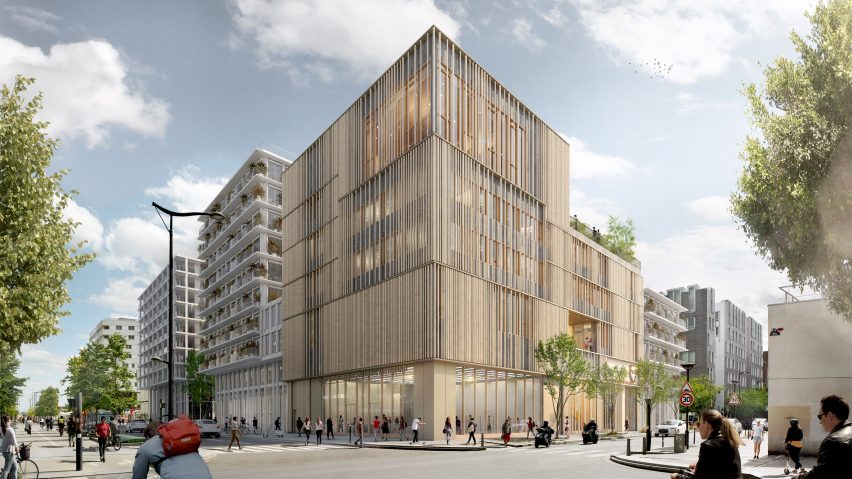Construction is progressing on a mass-timber academic building with a stone facade designed by architecture firm Studio Gang for the University of Chicago campus in Paris.
The University of Chicago John W. Boyer Center was designed by Studio Gang in accordance with the French sustainability law requiring new public buildings to be built from at least 50 per cent wood or other natural materials.
Aligned with president Emmanuel Macron's goal for France to be carbon-neutral by 2050, the law was implemented in 2022 and set out to reduce the carbon impact of buildings.
It aims to prioritise low-carbon bio-based materials such as wood, hemp and straw over other construction materials like concrete and steel.
Once complete, the Paris-based University of Chicago centre will have a lightweight hybrid structure made from mass timber set atop a steel ground floor structure that spans across an existing concrete grid.
Located in Paris Rive Gauche in the city's 13th arrondissement, the building's external facades will be decorated with fibreglass batons coated in Lutetian limestone.
According to Studio Gang design principal Rodia Valladares, the limestone was sourced from the Saint Maximin quarry, which is approximately 40 kilometres from the building site.
"This type of limestone not only underlies much of the Paris region but has also been a popular local building material since antiquity," Valladares told Dezeen.
"It allowed our project to not only align with the ambitious environmental standards set forth by the French government, but create a material connection between the building, its site, and the larger urban context."
Valladres explained that the building's carbon footprint was minimised by implementing multiple environmental strategies, including passive ventilation and lighting.
"In addition to using less-carbon-intensive materials for the structure and facade, the building also optimises its energy performance by using the district energy system and providing abundant natural ventilation and access to daylight," he said.
Designed in collaboration with local architecture studio Parc Architectes, the centre is an expansion of the existing University of Chicago Paris campus and triples its size to facilitate increasing study and research needs by faculty and students.
The building was arranged as a "vertical campus" that connects with the surrounding neighbourhood and provides a vibrant academic space for students.
"Inside, the building is organised as a vertical campus that creates dynamic visual and physical connections between programs to foster different kinds of exchange – academic, cultural, social – between students, faculty, visitors, and Parisians," said Valladares.
The centre will contain an amphitheatre, library, laboratory classrooms, biodiverse roof gardens and a double-height hall on the top floor.
A central garden courtyard will let in natural light and ventilation to the building, and provide green space for people to study and socialise.
Creating an animated facade, the stone batons wrapping the exterior will be spaced wider apart in front of windows to give views of the interior spaces from the street.
The centre will be connected to the wider city by a regional rail station located directly under it.
Expected to be completed in autumn 2024, the University of Chicago centre in Paris will be Studio Gang's first project in France.
Other mass-timber projects by the firm include the expansion of Kresge College for the University of California and its design for an open-air theatre in the Hudson Valley.
The images are by Splann courtesy of Studio Gang unless stated.

